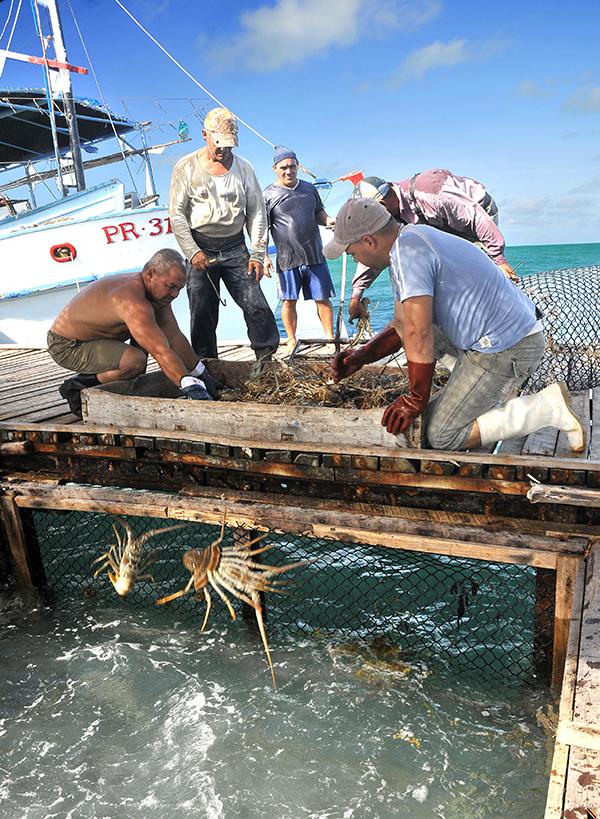
For the fishing industry, saying that you must make the best of bad weather is just right. While 2015 did not see the expected number of lobsters arrive to Cuba’s coasts, the largest firm dedicated to harvesting these crustaceans in the country is seeking alternatives this year in order to satisfy domestic demand.
The La Coloma Industrial Fishing Company (EPICOL), located south of Pinar del Río, reported a production shortfall of about 300 tons in the 2015 lobster catch, of which 90 - 95% is exported, with the rest destined for the island’s tourism sector.
According to EPICOL Director of Production, Technology and Quality, Midalys Naranjo, this deficit was due to a lack of cold fronts, which prevented lobsters from moving towards the surface in the months of the fishing season. As such, the planned catch of 2,123 tons of lobster for the year was not met.
Naranjo added that while lobster is La Coloma’s main export item, given the increase of tourism in Cuba throughout 2015, priority was given to the domestic market, which received the majority of the year’s production.
She also explained that while Cuba is an island, it does not have much fish. “Today the priority of fisheries is the hard currency domestic market, as when tourists come to Cuba they ask for fish,” she told Granma International.
She noted that the best catch of any species are destined for the tourist sector in different forms: dressed fish, in fillets or steaks or, to a lesser extent, finely chopped.
With the majority of the La Coloma fishing fleet (63 boats) dedicated to the lobster catch, according to Naranjo the major international markets for the island are China, Japan and Canada. In terms of sales to the general population, only the mass of the head is distributed, in small quantities.
The EPICOL fleet is completed by 16 tuna boats, 25 for scaly fish, three for oysters and one boat for sea cucumbers. Given its privileged geographical position in the fishing triangle of the Island, La Coloma also provides the largest amounts of bonito fish in the country.
However, with an essential source of EPICOL income limited in 2015, given the low lobster catch, all industrial production was impacted at the enterprise, which employs almost two thousand workers.
A MORE PROMISING SCENARIO
With the tuna fish family, of which bonito is a member, the planned catch of 720 tons for the year was surpassed. Part of the catch was destined for the hard currency market, with extensive national distribution.
The improved results in this area were marked by investments made in the purchase of four new boats, of which two are already operating, with the others due to come into operation in 2016.
In terms of scaly fish – that is the rest of the species fished – a total catch of 1,273 tons was planned for 2015, which was met thanks to the efforts of the highly experienced personnel, 96% of whom come from the La Coloma fishing community itself.
Affiliated with the Food Industry Enterprise Group, the state company, created in 2011, uses a scale of seven groups of fish, rated according to the quality of their scales.
In the first group, for example, are snapper, wahoo and red grouper. Then come yellowtail snapper and lane snapper, described as “dinner fish”, which are tasty though small. And so on up until the seventh group, which includes sardines and herrings, among others.
The latter are freely sold to the population and do not form part of the subsidized, rationed distribution network. Midalys Naranjo added that large catches were seen in 2015, specifically in groups five, six and seven, which are best for producing restructured fish products.
TOWARD INDUSTRIAL PRODUCTION
Naranjo highlighted that the company was formerly dedicated purely to lobster and bonito fishing. However, as catches rose, so did investment for the processing of fish and the elaboration of fish croquettes, hamburgers and other products.
The industrial side of EPICOL boasts high production levels and pursues diversification in its range of products, while continuing a strategy to make better use of lower quality fish species in finely chopped or restructured fish products.
In spite of technological difficulties, adequate industry conditions are prioritized through the use of Chinese equipment, especially in regards to refrigeration.
La Coloma previously produced canned bonito for the whole country; however the packaging used can not currently be manufactured in Cuba, thus increasing the final cost of the product due to the need for imported packaging. Despite this, Naranjo highlighted that an experiment in the production of canned fish will begin in 2016.
She also emphasized that a new line of vacuum packed fish products will be launched over the coming months, beginning with cutlets of bonito and sardines.
With the vacuum packaging machines already purchased, this technology will also be used to provide a better finish to other products such as hamburgers.















